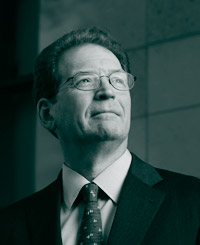Letter from the Dean

It was an office visit nearly 20 years ago, yet I remember the April 1995 day as if it were yesterday. My patient was a 50-year-old man with a strange problem: Whenever he whistled or hummed loudly, objects seemed to him to move around “like on a clock face.”
As an otolaryngologist, I was used to patients who found their symptoms perplexing. The vestibular system, my area of focus, controls balance and eye movements, and when it malfunctions strange things happen. But this man’s condition had me perplexed as well.
Over the next months some other patients reported similarly odd symptoms. One man told me he got dizzy when he sang in the shower. Another patient said she could hear the sound of her own eyes moving. Some patients assumed the problem was psychological until their psychiatrist referred them to me.
What was the culprit? My hunch was that it had something to do with the small, curved tubes in the inner ear that help us sense motion — the semicircular canals. I first tested my theory by observing these patients’ eye movements in response to loud noises — a technique used over a century ago for defining the relationship between each of the three semicircular canals and the eye movements that result from their activation. I found that a canal was indeed involved in causing this bizarre constellation of symptoms and signs: the superior semicircular canal.
When I explored further using the advanced imaging techniques of the day, I discovered the patients had tiny holes in the bone overlying this canal. The openings allowed changes in intracranial pressure or sound transmitted through the inner ear to cause motion of fluid in the superior canal and that in turn led to the symptoms and the eye movements. I labeled the openings with the word dehiscence and thus “superior canal dehiscence syndrome” entered the medical vocabulary.
I was glad to have discovered the cause and manifestations of the syndrome, but what mattered most to me, and certainly to my patients as well, was figuring out how to treat it. So I was extremely pleased that the surgical procedure I devised alleviated my patients’ symptoms — and could be used to reduce the suffering of hundreds of others.
In operating rooms today, patients benefit from spectacular innovation. Perhaps the most revolutionary change during my lifetime has been a shift toward minimally invasive surgery. Instead of traditional approaches, which often require large incisions and extensive manipulation of tissues and organs, many surgeries are now accomplished through tiny entry portals. This low-impact approach to surgery usually results in less risk of infection, less pain, less damage to tissues and faster recovery. Instead of a week in the hospital for gall bladder removal, most patients can be back home the next day.
At Stanford Medicine, innovation is part of our culture, so it’s no surprise that we’re a hotbed for new techniques and technologies that improve surgery results. Among recent advances: brain surgeries that bypass easily damaged healthy tissue by using the nostril as an access route, tools for minimally invasive surgeries sized to treat children, a retraction device that protects against wound infection and a post-surgical dressing that reduces scarring.
The power of innovation in surgery continues to amaze me. It inspires me to push ahead with our initiatives to transform the science and practice of medicine for a healthier world. It fills me with gratitude for the patients who enable innovation to move forward. And it explains why I’m so proud of Stanford Medicine, where innovation flows freely.
Sincerely,
Lloyd B. Minor, MD
Carl and Elizabeth Naumann Dean of the School of Medicine
Professor of Otolaryngology-Head & Neck Surgery